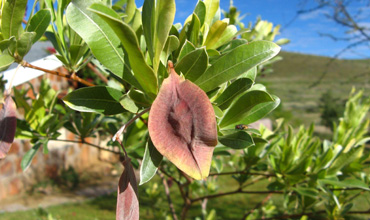The Antimicrobial Properties of Terminalia Glaucescens and Zanthoxylum Zanthoxyloides Extracts and the Spectrum of their Activity

Abstract:
The antimicrobial activity of the
ethanol extracts of two Nigerian chewing sticks (Terminalia glaucescens and Zanthoxylum
zanthoxyloides) against oral bacteria
and fungi isolates implicated in dental caries were assessed. The aim of the study is to isolate microbial organisms associated
with dental caries and to assess the antimicrobial activity of the ethanol extracts
of Zanthoxylum zanthoxyloides and Terminalia glaucescens stem used as chewing sticks.
The dental
extracts from 20
(twenty) patients with clinical features of dental caries were collected from School
of dental technology and therapy clinic, Trans-ekulu, Enugu. The patients comprised
of 8 males and 12 females with ages ranging from 16-40 years. The disc diffusion
method was used in evaluating sensitivity to the extracts and it was observed that
all the isolates were sensitive to T. glaucescens at different levels of concentration
with a MIC and MBC of 6.25mg/ml for S. pyogenes. The isolated and tested dental
pathogens were Escherisia coli, Pseudomonas aerugenosa, Streptococcus mutans, Streptococcus
pyogenes, Staphylococcus aureus and Candida albicans. However, of the all the isolates
E. coli proved resistant to Z. zanthoxyloides extract. Conventional antibiotics
were used as positive control while distilled water was used as negative control.
The ability of T. glaucescens and
Z. zanthoxyloides extracts to inhibit the growth of the bacteria and fungi in this
study is an indication that the plant can be used as a source for antimicrobial
agent in the formulation of toothpaste and mouth wash, thus justifying the use of
the plant locally as chewing sticks.
References:
[1]. Akande, J.A.
and Hayashi, Y. (1998). Potency of extract contents from selected tropical chewing
sticks against Staphylococcus aureus and
Staphylococcus auricularis. World Journal of Microbiology and Biotechnology,
14: 235-238.
[2]. Barry, A.L.
and Thornsberry, C.P. (1991). Susceptibility Tests: Diffusion Test Procedures. In:
Balows A, editor. Manual of Clinical
Microbiology. 5th ed. Boston: Asm International; pp. 1117–25.
[3]. Fejerskov,
O. R. and Kidd, E.N. (2003) .Dental caries: the disease and its clinical management.
1st ed. London: Wiley-Blackwell.
[4]. Fudulu, S.O.
(1975). Antimicrobial properties of the
buffer extracts of chewing sticks used in Nigeria. Planta medica; 27: 123-126.
[5]. Holding J.A.
and Colee, J.G.(1971). “Routine biochemical tests,” in Methods in Microbiology, vol. 6, pp. 592–599.
[6]. Holt, J. G.,
Kreig, N. R., Sneath, P., Staley, J. and Williams, S.(1994).Bergey's Manual of Determinative
Bacteriology. 9th Edition.Williams & Wilkins, Baltimore. Pp. 65-73.
[7]. Kleinberg,
I. (2002) .“A mixed-bacteria ecological approach to understanding the role of the
oral bacteria in dental caries causation: an alternative to Streptococcus mutans and the specific-plaque
hypothesis,” Critical Reviews in Oral Biology
and Medicine, vol. 13, no. 2, pp. 108–125.
[8]. Ogundiya, M.O.,
Kolapo, A . L., Okunade, M .B. and Adejumobi, E. (2014). Evaluation of Phytochemical
Composition and Antimicrobial Activity of Terminalia
glaucescens Against Some Oral Pathogens. Advances Natural & Applied Sciences, 2(2): 89-93.
[9]. Pretorius, J.C.,
Magama, S. and Zietsman, P.C. (2003).Growth Inhibition of Plant Pathogenic Bacteria
and Fungi by Extracts from Selected South African Plant Species. South African. Journal of Botany, 20: 188-192.
[10].
Schaeken,
J.M., Van der Hoeven, J.S. and Franken, H.C.(1986). “Comparative recovery of Streptococcus pyogenes on five isolation
media, including a new simple selective medium,” Journal of Dental Research, vol. 65, no. 6, pp. 906–908.
[11]. Wolinsky, L.E.
and Sote, E.O. (1984). Isolation of natural plaque-inhibiting Substances from Nigerian
chewing sticks. Caries Research, 18:216-225.

